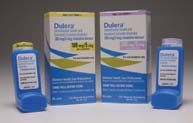Publication
Article
Pharmacy Times
A Closer Look at New FDA Actions Merck's Dulera
Author(s):
Dulera (mometasone furoate and formoterol dehydrate) Inhalation Aerosol is FDA-approved for the treatment of asthma in patients aged 12 and older.
Dulera (mometasone furoate and formoterol dehydrate) Inhalation Aerosol is FDA-approved for the treatment of asthma in patients aged 12 and older.

Dulera is a metered-dose inhaler that combines an inhaled corticosteroid (mometasone furoate) with a long-acting beta2-agonist (formoterol fumarate). Dulera is indicated for the treatment of asthma in patients aged 12 years and older. Use should be limited to patients with inadequate control with inhaled corticosteroids, or those whose asthma severity indicates use of combination therapy. Dulera is not indicated for the relief of acute bronchospasm.1
Asthma is a chronic inflammatory lung disease characterized by recurrent episodes of coughing, wheezing, shortness of breath, and chest tightness as a result of airway obstruction. Airway obstruction occurs from a combination of inflammation of the bronchi, airway smooth-muscle constriction, and airway hyperresponsiveness (an exaggerated bronchoconstrictor response to stimuli). With more than 23 million Americans (300 million people worldwide) living with asthma, it is one of the most common and costly chronic diseases.2,3 Annually, this disease leads to an economic cost of $15.6 billion in direct health care costs ($5.6 billion in prescription drug costs alone) and an additional $5.1 billion in indirect costs (lost productivity).4 Although there is no cure for asthma, it can be managed with proper treatment.
Pharmacology
Dulera contains both mometasone furoate and formoterol fumarate. These drugs represent 2 different classes of medications that have different modes of action and show additive effects in terms of establishing asthma control. Mometasone furoate is a corticosteroid that produces topical anti-inflammatory activity in the airways. The exact mechanism on asthma is not known, however. Formoterol fumarate is a long-acting selective beta2-agonist that acts as a bronchodilator in the lung.1
Dosing and Administration
Dulera is a metered-dose inhaler that is available in 2 strengths: Dulera 100 mcg/5 mcg and Dulera 200 mcg/5 mcg. Each inhalation contains either 100 mcg or 200 mcg of mometasone furoate with 5 mcg of formoterol fumarate. The recommended starting dose is based on prior asthma therapy. In patients with previous medium- dose inhaled corticosteroid use, initiate Dulera 100 mcg/5 mcg, 2 inhalations twice daily. In patients with previous highdose inhaled corticosteroid use, initiate Dulera 200 mcg/5 mcg, 2 inhalations twice daily. The maximum daily recommended dose is 2 inhalations of Dulera 200 mcg/5 mcg twice daily every day in the morning and evening. No more than 2 inhalations twice daily of the prescribed strength of Dulera can be used, as some patients may experience adverse effects with higher doses of formoterol. After each dose, patients should be advised to rinse their mouths with water without swallowing.1
Contraindications, Warnings, and Precautions
Dulera is contraindicated in patients with status asthmaticus or other acute episodes of asthma, as well as in patients with known hypersensitivity to mometasone furoate, formoterol fumarate, or any of the ingredients in Dulera. Long-acting beta2- agonists, such as formoterol fumarate, have been associated with increased risk of asthma-related death. Dulera should not be initiated during acute asthma exacerbations, and is not indicated for treatment of acute symptoms.1 Patients taking Dulera should be monitored for increasing asthma symptoms and increased need for short-acting beta2-agonists. The recommended dose should not be exceeded. Other long-acting beta2-agonists (salmeterol [Serevent] or formoterol [Foradil]) should not be used with Dulera. Patients should be monitored for systemic effects of corticosteroids, including reduced bone mineral density and adrenal suppression due to the possibility of systemic absorption of mometasone furoate.
In clinical trials, the most common treatment-emergent adverse events were nasopharyngitis, sinusitis, and headache, which were reported at an incidence of ≥3%. Oral candidiasis has been reported at an incidence of 0.7% in patients receiving Dulera 100 mcg/5 mcg, 0.8% in patients receiving Dulera 200 mcg/5 mcg, and 0.5% in the placebo group. Dysphonia was observed in a longer term (52-week) trial in patients receiving Dulera 100 mcg/5 mcg (5%) and 200 mcg/5 mcg (3.8%). No significant drug interactions were noted with other commonly used medications in the treatment of asthma. Caution should be exercised, however, when considering coadministration with strong cytochrome P450 3A4 inhibitors such as ketoconazole (eg, Nizoral), which may increase plasma levels of mometasone. Dulera is in pregnancy category C and should be used during pregnancy only if the potential benefit justifies the potential risk to the fetus.1
Dr. Garcia is a clinical pharmacy specialist in primary care at Aldine Health Center in Houston, Texas.
References
- Product information for Dulera. Schering Corporation, a subsidiary of Merck & Co, Inc, Whitehouse Station, NJ 08889.
- National Institutes of Health, National Heart, Lung, and Blood Institute. Global Initiative for Asthma (GINA). Global Strategy for Asthma Management and Prevention. Updated 2009. Bethesda, MD; 2009.
- National Institutes of Health, National Heart, Lung, and Blood Institute. National Asthma Education and Prevention Program Expert Panel Report 3. Guidelines for the Diagnosis and Management of Asthma. NIH Publication No. 08-5846. Bethesda, MD: National Institutes of Health; October 2007.
- Trends in Asthma Morbidity and Mortality. American Lung Association, Epidemiology and Statistics Unit. Washington, DC; February 2010. Available at: www.lungusa.org/finding-cures/our-research/trend-reports/asthma-trend-report.pdf. Accessed August 3, 2010.







